Church St. Demetirus in the village of Gradeshnica
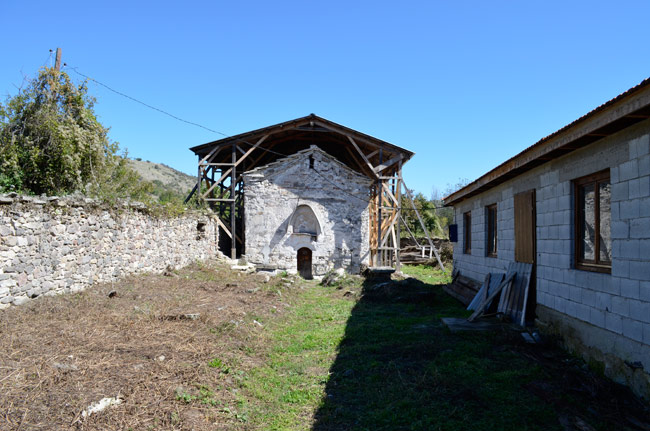
There are nine churches in the village of Gradeshnica. One of the oldest is the church of St. Demetrius which some authors consider dating from XIV or XV century.
The temple of St. Demetrius, regrettably, was very little researched so far, although in 1992 a decision for a status of immovable cultural monument was issued.

Village Gradesnica
In the past the team of the Republic Institute for Cultural Monuments Protection has made a record of the monument of culture in Mariovo area, including basic data only. In the course of 2000 NI Institute for Culture Monuments Protection and Museum Bitola undertook some preventive measures relating to the architecture and wall-painting.
Some authors date the wall-painting of the church from end of XIV and beginning of XV century, but other authors’ researches date a part of the wall-painting and built iconostasis in the beginning of XVI century.
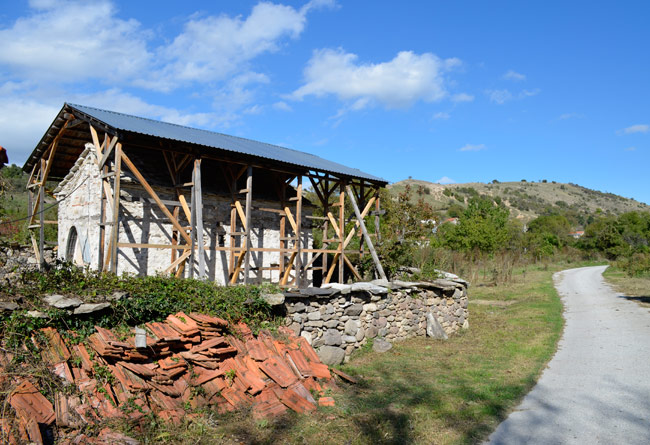
The church of St. Demetrius is located at the entrance to the village along the road leading to the village. The church has been constructed as one-nave building with rectangular base having entrance on the west side and apse on the east side. It has been built of cut stone and semi-cut stone blocks which also has been used for the semi-circular vault. At the entrance on the west side in a concave niche St. Demetrius, the church’s patron has been depicted. The wall painting is not entirely preserved. The interior almost all of its area (east, west, north, south wall, the vault and the built iconostasis) has been wall-painted on a surface of lime plaster. Today the wall-painted areas are not entirely preserved because of the damages incurred on the church construction over the time.
Quite impressive is the massive stone iconostasis separating the nave from the sanctuary. In the nave marble pillars are set one on the north and one on the south side of the nave. Through the pillars and the iconostasis three blind arches have been built above which the stone vault arises.
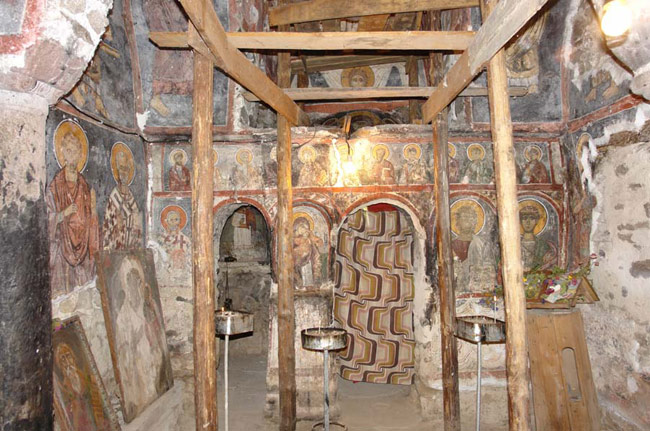
Nave of the church to east
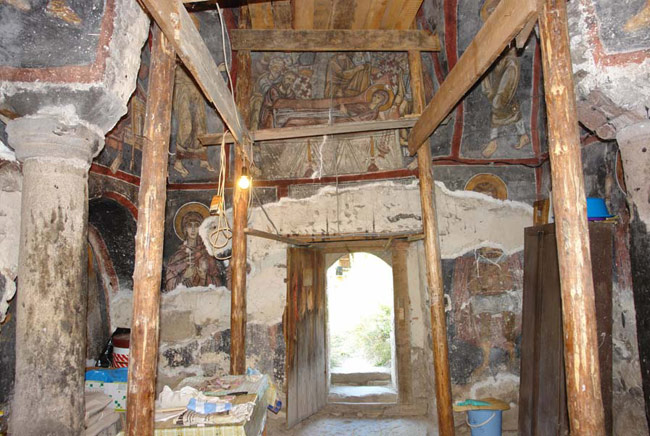
View to the church from west
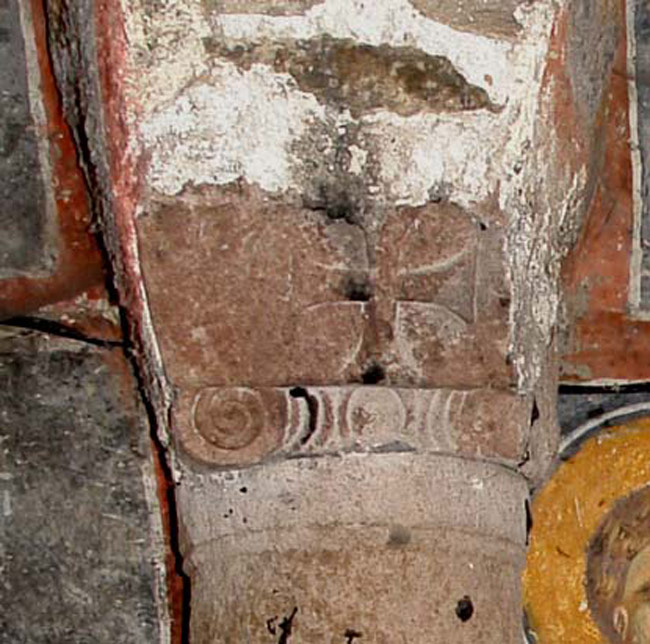
Detail of the capital of marble pillar to the north wall of the nave
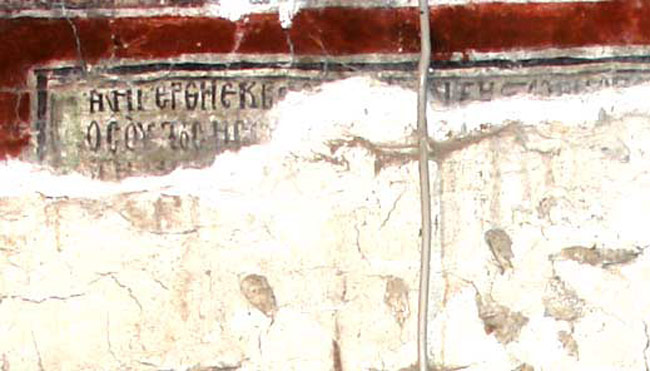 Detail of the inscription on the west above the entrance gate
Detail of the inscription on the west above the entrance gate
Some authors declare that the frescoes in the nave of the church and the iconostasis evidently differ from frescoes in the apse and date the built iconostasis in the XVI century. But, according to our conclusions based on certain indicators, we date the painting even earlier i.e. in the period to the end of the XIII century. Perhaps future conservation and restoration researches using other disciplines will allow us to confirm our assumptions.
We were unable to provide more detailed information about the iconographic program because of the non-perspicuity of the wall painting from various reasons. According to previous observations our thoughts go in two directions:the frescoes belong to two different time periods, where the older frescoes were painted by a particularly skillful and talented painter, but more likely is the assumption that the fresco painting is the work of local monastic enclave. During the wall painting assistants worked alongside the master, the upper portions were done by the assistants, while the master in the first areas in the nave, altar and iconostasis. There are also some modifications such as retouching of more recent times, perhaps modifications dating from an older period. However, in order to confirm these assumptions additional researches are needed supported by other scientific disciplines.
A special place in the church takes the iconostasis. The iconostasis of the church belongs to the type of built ones that appear the earliest on territories under Byzantine domination in XIII century. In the Republic of Macedonia there are several churches with built iconostasis, they appear in XIV, XVI and XVII century, as it is the Church of St. George in Old Nagorichino, Church of St. Nicholas in Shopsko Rudare, church of St. Athanasius in the village of Sloestica, Demir Hisar.
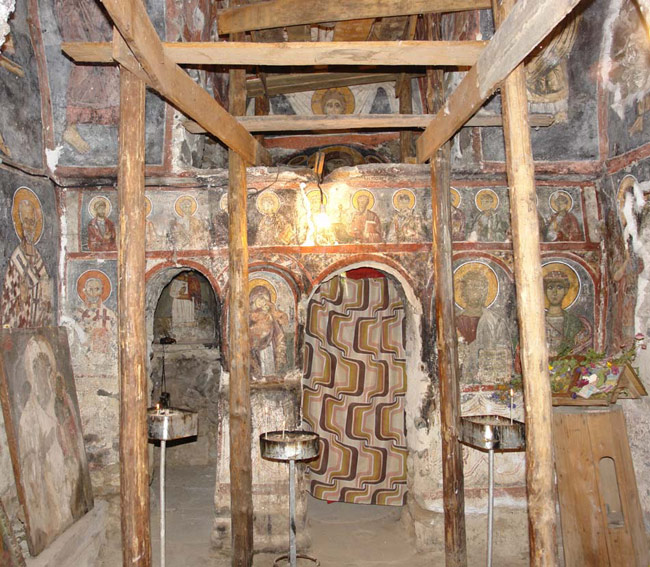
The built iconostasis
The iconostasis of the church is built of semi-cut stone, bonded with mortar separating the altar through the entire width of the nave. The entrance to a sanctuary is located centrally. In the upper part it is vaulted. There is an entrance from the north side leading to the prosthesis that is also vaulted. The iconostasis is decorated with fresco icons instead of icons painted on wood. In the lower part i.e. the baseboard drapery is painted in lighter and darker nuances of yellow ochre, decorated with vegetable motif depicted in red and black color. The end of the drapery is depicted with wide red ribbon. Above the drapery on the south side of the iconostasis bust of Jesus Christ the Saviour is painted who blesses with right hand and holds an open Gospel in the left hand. Jesus Christ is depicted in deep red chiton and whitish himation. Next to him, bust of the holy warrior Demetrius is depicted. St. Demetrius wears army clothes, holding a sword with right hand and short knife in the left. St. Demetrius’ head is decorated with ceremonial diadem decorated with precious stones- pearls. On the left from the warrior a round-shaped shield is depicted. The shield is painted in purple and red shades and decorated with vegetable ornaments and one anthropomorphic detail.
The garment i.e. the cloak is painted in olive-green color, the red color was used for the tunic, while the armor is depicted with grayish nuance. Towards the north side of the central entrance to the altar, in a niche, the most impressive scene of Theotokos is depicted of type Eleusa or Theotokos the Merciful. Theotokos holds little Jesus in her arms, caressing him with her cheek. She is painted very emotionally expressing human traits. Theotokos is painted in lavish maphorion in dark carmine color lined with yellow-reddish nuance of ochre, while the little Jesus is depicted in short hiton in yellow ochre shades. On the ultimate northern side to the entrance of prosthesis bust of St. Nicolas is depicted in white poly-staurion decorated with black crosses and omoforos with red crosses. The Saint holds closed Gospel in the left hand, which is depicted with red ochre and decorated with pearls and blesses with right hand, which is fragmentary preserved. The Saints deployed on the place of throne icons are put in frames in the form of ribbon with width of 4 cm., both sides emphasized with thin white line. The image of St. Nicolas is placed in rectangular depicted frame while the others are in the form of arches in the upper part or like semi-circular niches, except the image of Theotokos Eleusa which is depicted in a niche and additionally stressed with red ribbon. This image is being emphasized with another decoration in a form of zig-zag painted ribbons that follow the shape of the niche. In the lunette above the image of Theotokos cryptogram text has been written. The background of the images is in light grey-blue color, while in Theotokos’ image the upper part is in light grey-blue color, while the lower in green shade.
The Saints’ nimbi are depicted with yellow ochre, highlighted with thin white lines. Their faces are depicted stratified in yellow ochre in graded shades, green shadows and whitish accents. Signatures are written in white on Greek Byzantine language.
The architrave which extends along the entire length of the iconostasis in a rectangular field limited with red stripes (top and bottom) are painted busts of the twelve apostles. Over the heads of the apostles separated by bordure there is an inscription along the entire length of the iconostasis. Apostles Peter and Paul are depicted centrally. Behind Peter the apostles Luke, Mark, Andrew, James and Bartholomew are depicted, while behind Paul the apostles Matthew, John, Thomas, Simon and Philip. On the side of Peter, the apostles holdt Gospels, and the side of the Apostle Paul the apostles hold closed scrolls.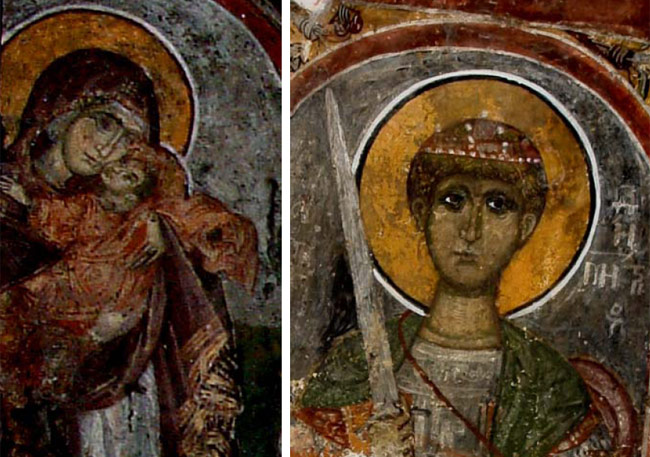
Details of the built iconostasis, Theotokos Eleusa and St. Demetrius
In the first zone of the east wall in the alter the compositions Adoration of the Holy Fathers – Archpriests to the Lamb whose location has been determined by the ecclesiastical cannons and the way how they should be represented in the altar. Centrally, little Jesus is depicted reclining on the holy table and blesses with the right hand. Behind him there is painted architecture (church and other buildings), left and right there is an angel in white deacon clothes holding in hands a ripida that ends with an eight pointed star. The eight pointed star in the Christianity symbolizes the eights eons of Christ’s glory. On the right side St. Basil is depicted wearing white polystaurion with black crosses and deep red crosses on his omoforos. On the left side St. John Chrysostom and St. Athanasius are depicted also wearing poly-staurions, with a note that St. Athanasius of Alexandria’s omoforos is depicted with black crosses.This composition is unique and rare because of the presence of Lord’s angels with eight pointed stars and architectonic details, which is a rarity in presenting this composition. Similar composition we see in the altar of the church St. Theotokos in the village of Graeshnica – Bitola area dated to the beginning of the XV century.
Adoration to the Lamb – east wall of the altar
In the church of St. Demetrius there are inscriptions on the composition Adoration to the Lamb in church Slavic, while on the other compositions - in the altar, nave of the church, we meet inscriptions on Greek language that are accepted as epithets and characteristic Greek designations adopted in the Christian ecumena, e.g. Christ Emanuel in the painting of Our Lady of the Sign. Further, in the first zone of the niche of prosthesis St. Stephan Proto-martyr in white garment has been depicted.
Above this composition in a semi-calotte of the apse bust frontal image of Theotokos has been depicted wearing deep red maphorion on whose chests in a clypeus-shape Christ Emanuel has been depicted in red chiton and ochre yellow himation. Above the shoulders of Theotokos at the height of her head circular medallions are depicted with intensive red color lined with strap in ochre yellow. Inside the medallions the signatures are inscribed that mean God’s Mother. Iconographic type of Our Lady of the Sign is a form of Peribleptos with hands raised in prayer. This composition has been made according to the text of the prophet Isaiah in which Theotokos is presented ad embodiment of the church - Ecclesiae Mater.
This iconographic type of the Virgin is an important indicator of the theme and chronology because in the wider sphere of Byzantine art it is present in the older art. In Macedonia and wider this iconographic type in XIII century begins to be replaced by another iconographic type called Oranta. Over the portrait of Our Lady of the Sign we meet another two important things in the iconographic program of the wall-painting’s author in the altar. Just above the conch the image of Christ is depicted on a white towel. The iconographic type is Translation of the Image of our Lord, god and Savior, Jesus Christ (Holy Napkin) which is also called Byzantine type or Salvatore type. This type originates from the beginnings of the church Christological disputes for presentation of the real character of Christ, and the church accepted two types. One of them is called Holy Napkin, that the character was not painted by a human hand, but a direct imprint of Christ's character.
According to Eusebius the story comes from the IV century when sick prince Abgar asked for help from the Savior. Trying to help him, because he was unable to come in person, he sent his imprint of the face on cloth. Prince Abgar when touched this character immediately recovered. After this, the towel as something very sacred was transferred under the name Mandelion to Constantinople. In iconographic type of character (imprint) of Christ in the Church of St. Demetrius he is depicted calm and hieratic, magnificent without thorny crown and in accordance with the Byzantine iconographic type. Above this image there is very rare iconographic representation of God the Father. For painting of this type usually has been used the model of Christ's character, but the hair and beard have been painted in whitish color to show the age difference between God the Father and the Son of God. Understanding of God the Father in the composition in the altar of the church of St. Demetrius is in line with the vision of the type "Vethi denmi" or the Ancient of Days described in the Prophet’s Daniel, Chapter 7, 9. The prophet describes him as an old man who sits, his clothes are white as snow, and the hair like wool, and the throne as a fiery flame. The composition in the church of St. Demetrius is approximate in graphical recording. God the Father has been depicted blessing with both hands, his clothes are painted in white color, drapery is made with azure brown-reddish and azure light green color. The hair and beard are painted white, and for emphasizing the tufts light brown and yellow ochre are used. Aureole is painted with yellow ochre and inside are depicted three (two side and one above the crown) rosettes with eight petals.
Usually inside the aureole eight pointed star is depicted, but in this case it is replaced with three rosettes resembling stars with eight petals that should represent the eight points of the star. The eight points symbolize the eight eons of future glory. Ancient of Days is depicted hovering in dual elliptical aureola painted with white color symbolizing the divine light. Two seraphim, representatives of the highest hierarchical order of heavenly angels, hold the aureola. Seraphim are painted with yellow ochre, but the wings and portraits of angels are lined with brown.

Altar – Portrayal of Our Lady of the Sign in the semi calotte of the apse
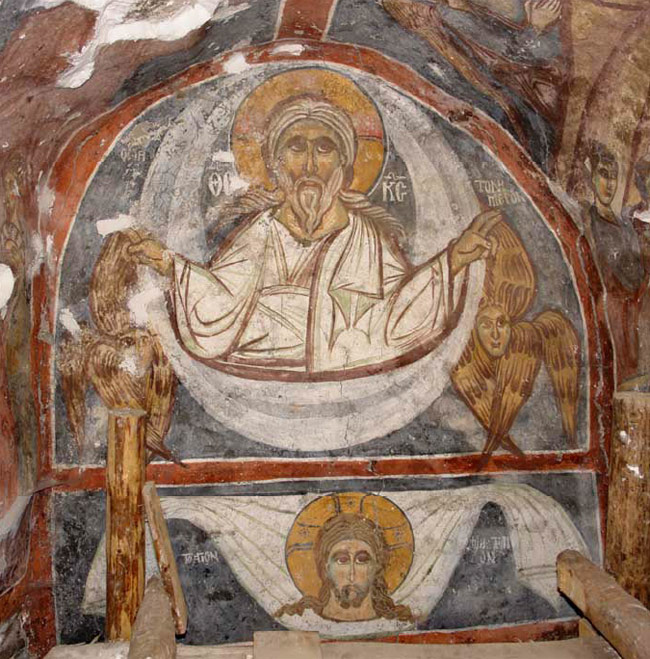
Altar – Portrayals of the Ancient of Days (upper part) and Holy Napkin (lower part)
Frescoes in the nave, which probably dates from the same period as the frescoes of the built ikonastas is in very poor condition. Preserved painted surfaces are protected with trimming on short-term to prevent falling. Many pigments used for painting are degraded, deteriorated, therefore their identification is not highly-rated. The scenes are framed with painted red stripes lined with white lines, background with slate-blue tone, and signatures are written with white color in Greek language from Byzantine period. On the west wall above the entrance door minimal fragment of an inscription is preserved which was probably mentioning the year of fresco-painting, as well as data for the founder and author. On the western wall of the first zone to the south two female saints are painted in full growth of which one is St. Paraskeva – Petka, while the other one cannot be identified; but we will mention as possible the figures of St. Theodore, St. Marina or St. Kyriake. In continuation to the north, in the first zone the Holy Warrior Procopius is depicted in full growth. St. Paraskeva-Petka wears a gown in brown and red color; the shadows are made with deep red carmine mixed with black; she firmly holds the cross in the right hand. Warrior’s armor is painted with yellow ochre, tunic in light gray and gown in carmine red.
Other holy warriors, St. Demetrius and St. George, are depicted in the first zone of the north wall next to the holy warrior Procopius. They wear military clothing with their attributes in the right hand: St. Demetrius with a sword and St. George with spear and shield. For painting heir armors yellow ochre is used, light gray for the tunics and carmine red for the cloaks. Nimbus is painted in intensive yellow ochre highlighted with thin white line.
Unmercenaries Cosmas and Damian in full growth are painted in continuation of the first zone of the north wall. St. Cosmas blesses with right hand holding probably a healing box in the left hand; his clothes are painted with brown shades. St. Damian holds a healing tool with right hand and healing box with his left hand; his clothes are painted in light brown tone and himation in light red color. At the end figure of St. Nicolas in full growth is depicted who blesses with right hand and holds open Gospel with the left. St. Nicolas is painted in white poly-staurion decorated with red crosses, while the omoforos is painted with black crosses. Generally said for the painting the painter used mostly warm colors against the background that is painted in slate-blue and on some spots in green. Saints’ nimbi are in intensive yellow ochre; signatures are written in white.
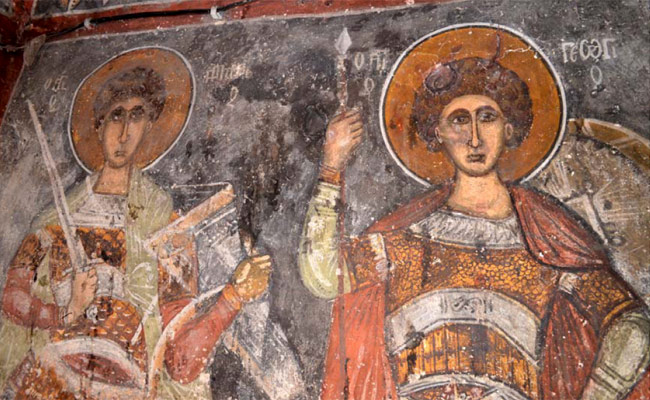
Part of the wall-painting of the north wall of the nave, left - the holy warrior Demetrius, right - holy warrior George
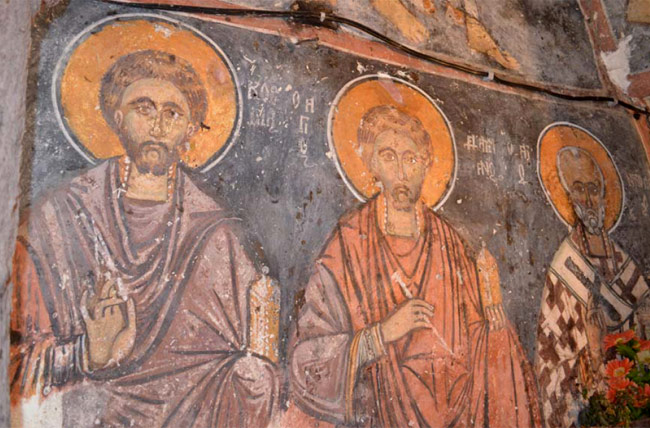
Holy Unmercenaies St. Cosmas and St.Damian on the north wall of the nave

St. Paraskeva-Petka on the west wall of the nave
Above the front door on the west wall of the nave – second zone - the scene Dormition of Theotokos is painted. Theotokos lies on the deathbed painted with red and bedspread with white drapery; in front of the bed there are two candlesticks. Fewer archpriests and apostles are present at the solemn act of Theotokos’ Dormition because of the space limitation. Carmine red, white and ochre yellow nuances are prevailing; archpriests’ poly-staurions are painted with red crosses. On north and south, the scene is flanked by figures of unidentified saints in full growth with clothing in nuances of yellow ochre. Vertically, in the third zone in continuation busts of holy martyrs are painted. On the north wall of the nave in second zone in the niche on west the image of Mark the Evangelist is depicted’ inside the arch towards west St. John the Baptist and the prophet Solomon are depicted, while in the arch on the east side there is no preserved wall-painting.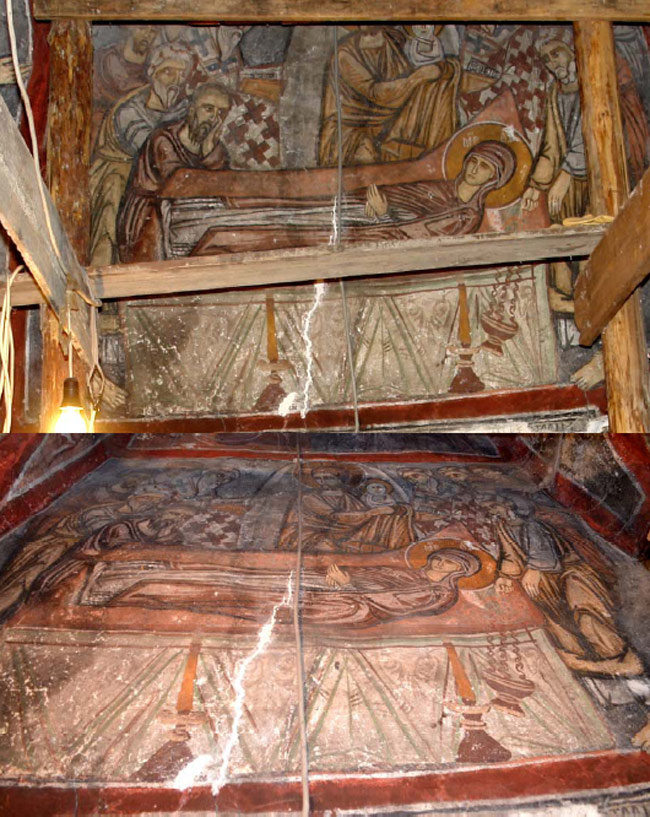
Composition of Dormition of Theotokos in the second zone of the west wall of the nave
On the south wall of the nave in the first zone starting from east to west the figure of the Archangel Michael is painted in full growth with a sword in his right hand. Unfortunately the wall-painting is partly preserved here. The preserved frescoes are characterized with beautifully harmonized colors of green, red, gray and brown, as well as precise painting of details of clothing and wings of the Archangel. Below there is an image of a saint that we cannot identify because of the fragmentary remains.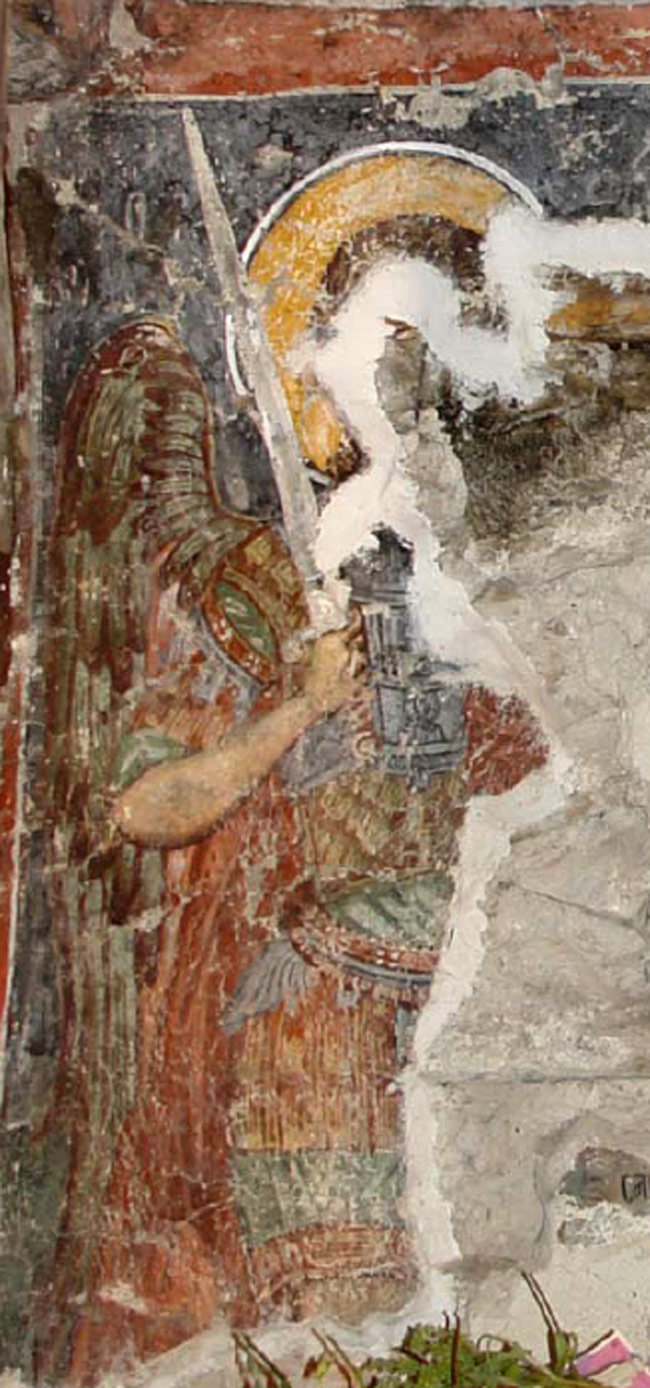
Archangel Michael in the south wall of the nave, the first zone

St. Nicholas, the north wall of the nave, first zone
Further, on the south wall of the first zone in a semicircular niche on gray-blue background the composition called Deisis is depicted where the figures of Jesus, Theotokos and St. John the Baptist are painted in full size. In the middle Jesus Christ Pantocrator is frontally depicted, he blesses with his right hand holding closed Gospel with his left hand. From his right side Virgin Mary is painted in semi-profile with both hands suppliantly raised to Christ. From the left side of Jesus St. John the Baptist is depicted also in semiprofile with both hands suppliantly raised to Christ. Limited number of colors is used for painting the clothes, as brown- reddish for the maphorion of the Virgin Mary and the chiton of Christ, gray for himation of Christ, while the clothes of John the Baptist is painted with mixed tones of gray and brown. Perhaps because of the lack of transparency and damages incurred to the colored layer precise identification of the colors cannot be done. Our idea is that perhaps at some time certain modifications have been done i.e. over-painting to the garments of the Saints. Otherwise, this composition is among the most representativeones, which subject has been taken from Psalm 45.10. but this variant is not so lavishly displayed.

Deisis composition on the southern wall of the nave
In the second zone over the composition Deisis also is wide arch-like niche John the Evangelist is depicted, sitting on a semi-circular chair and writes the Gospel inspired by the angel. Chair where he sits is painted with intense yellow ochre, richly decorated with white, red and black. Eastward in such a niche image of Luke the Evangelist is depicted preserved in fragments. Inside of the arc to the east prophets are painted, who can not be identified. Inside of the arc to the west the following images are painted: on the side facing east the prophet David, and to the west an image of an Old Testament prophet is saved who can not be identified.
In the third zone of the nave compositions of Christ's Holidays and Passion are presented.

Detail of the composition Nativity on the south wall of the nave
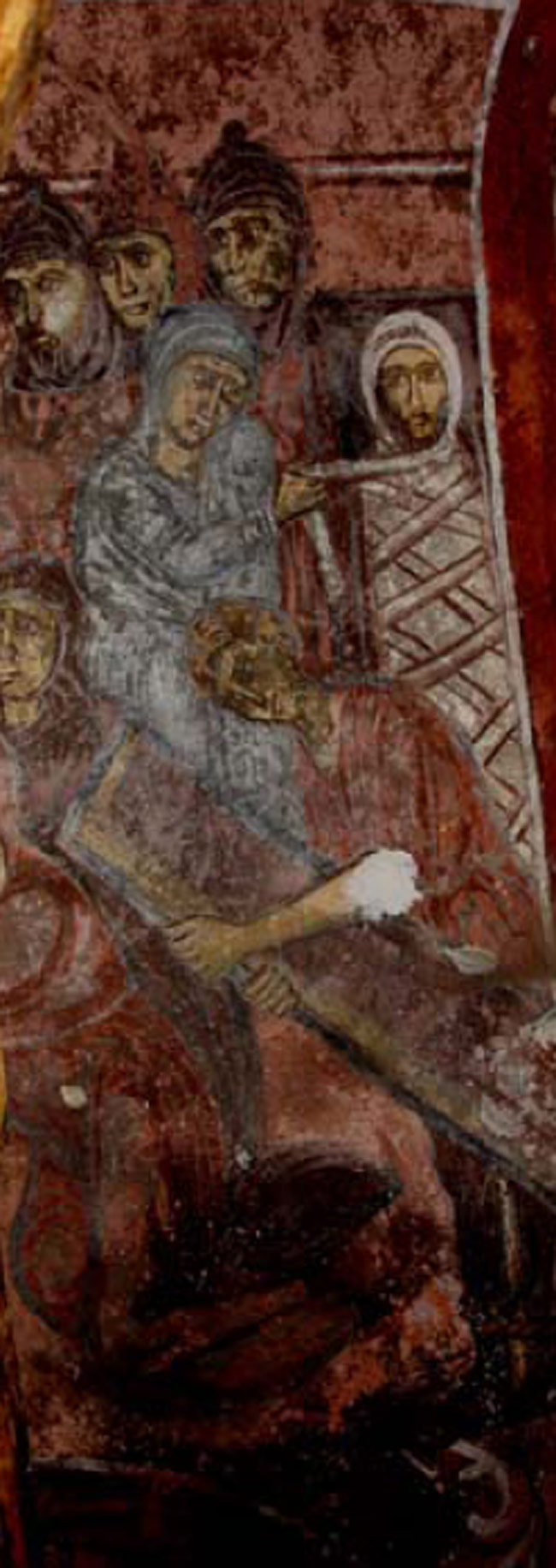
Detail of the composition Resurrection of Lazarus on the south wall of the nave
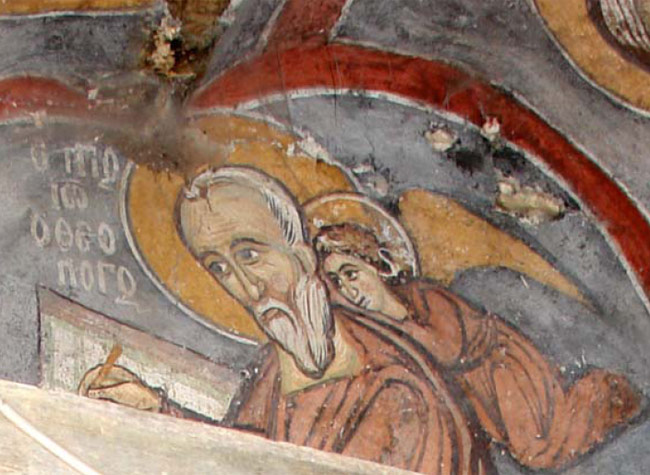
Detail of the image of John the Evangelist in the niche of the south wall of the nave
On the north wall from west eastward, probably the first scene is Jesus Christ before Pontius Pilate, next to it little preserved composition of the Crucifixion of Christ, but the last scene Descent into Hades is preserved. On the south wall from west eastward, Nativity is the first composition, next to it Baptism of Christ, and finally the Resurrection of Lazarus.
Coloring of painting figures, landscapes and architecture is a combination of warm colors in many nuances, while for painting the background cool colors are used, mostly gray-blue tones which gives an impression of a harmonious look, because of the proper dosage of intensity. Images’ anatomical parts, arms, legs, are painted on a base with variations of yellow ochre, pale green shades, brown contours to emphasize the eyes, eyebrows, nose, etc., white to emphasize the illuminated surfaces. For the image of Our Lady of the Sign, for the portrayals of the Virgin and Christ red color is minimally used on the faces’ surface. Hair of the saints, angels are mostly painted in brown, and tufts and curls are lined with yellow ochre. We estimate the wall-painting of the church of St. Demetrius with its characteristics from late Komnenos period, in the time under the ruling of Palaeologue dynasty. The existence inscriptions in church Slavic on monuments with religious wall paintings in medieval Macedonia is even noticeable in the beginning of the XIV century. Monuments within the diocese of Ohrid Archbishopric under Byzantine rule are mostly with Byzantine inscriptions, although there are few registered with Slavic inscriptions, like the church of St. Archangel in s.Varosh Prilep, St. Nicholas in the village of Manastir, in Prilep part of Mariovo, St. Mary Peribleptos in Ohrid, St. Mary in the village of Trebino, which can be linked to a certain stage in their building or painting with the church of St. Demetrius. Slavic inscriptions preserved in the church of St. Demetrius in Gradeshnica are dominant in the altar, and the Byzantine in the nave of the church. According to the analysis of the hand-writing in the inscriptions there are made by one zografos. Slavic inscriptions in the church of St. Demetrius in Gradeshnica are result of the vicinity of the monastic centers in which Slavic language was cherished or maybe in the period when the church of St. Demetrius has been wall-painted it has been within the Macedonian or Serbian medieval countries where Slavic language had an advantage over the Byzantine. Many open questions and considerations remain for future researchers on this wall painting, but we hope that our research has made sufficient contribution.
State of these beautiful frescoes is really sad, which we hope that appropriate measures will be undertaken soon for its preservation as a testimony of medieval religious art from our past. His feature - architectural solution, the built iconostasis, rare fresco iconographic compositions and, finally, its great antiquity obliges to act with special piety to its existence through the time.

Our Lady of the Sign
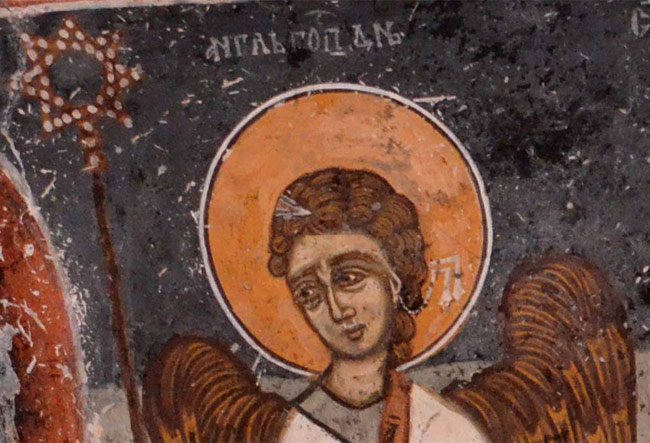
God’s Angel
Text: Olivera Makrievska
NI Institute and Museum Bitola
